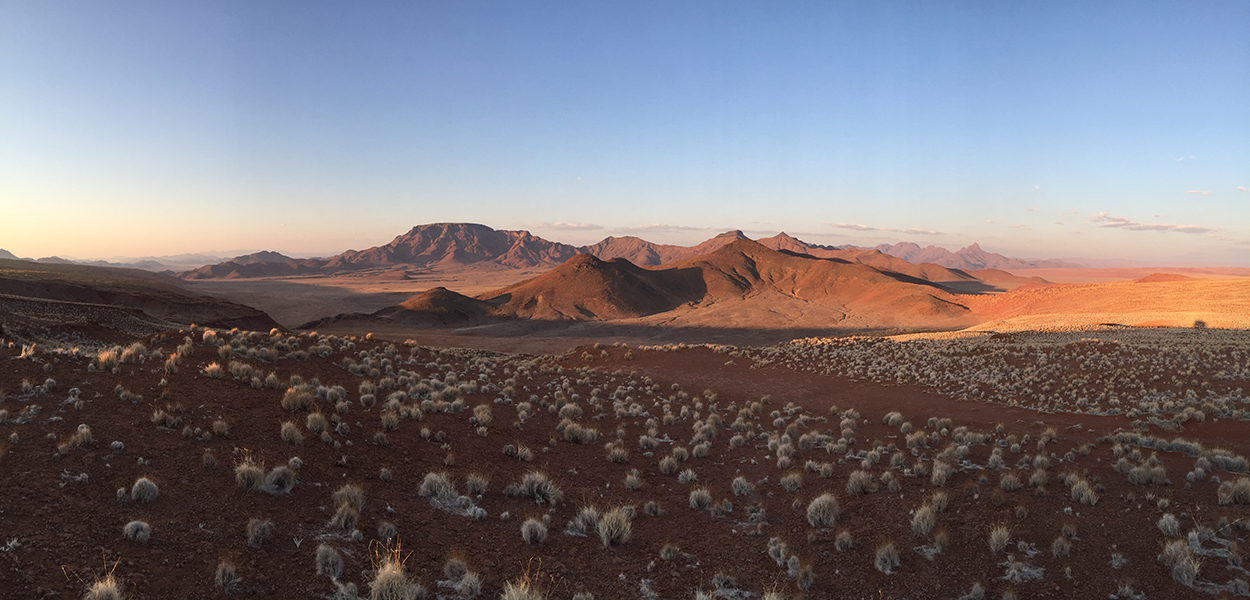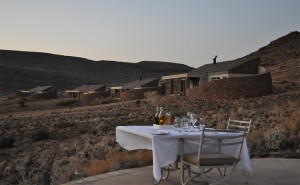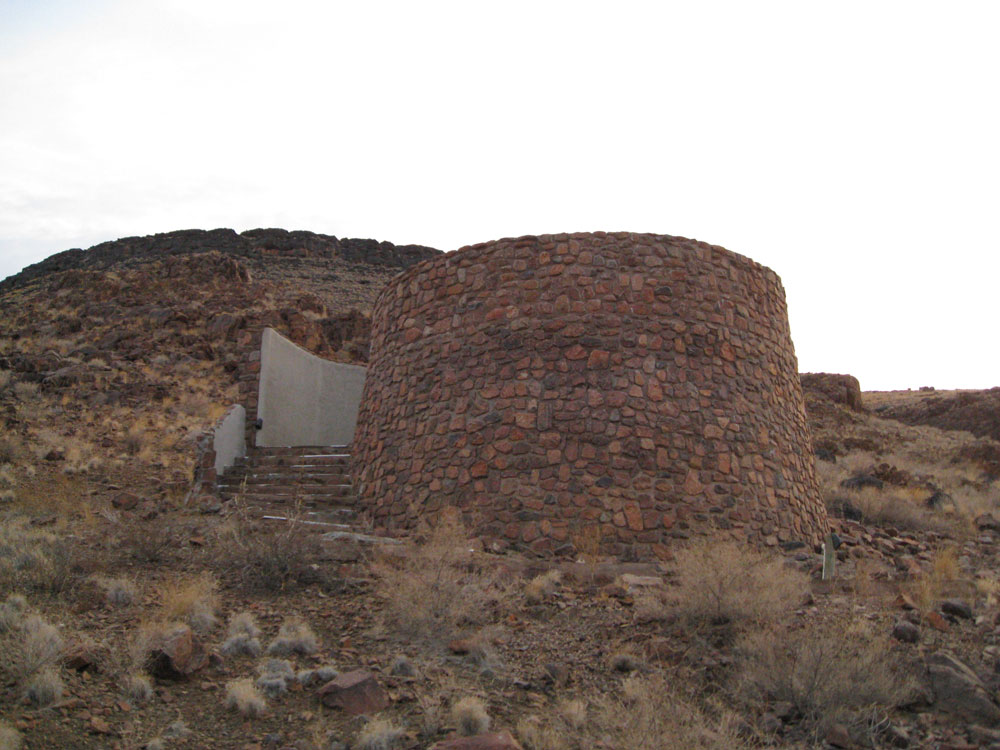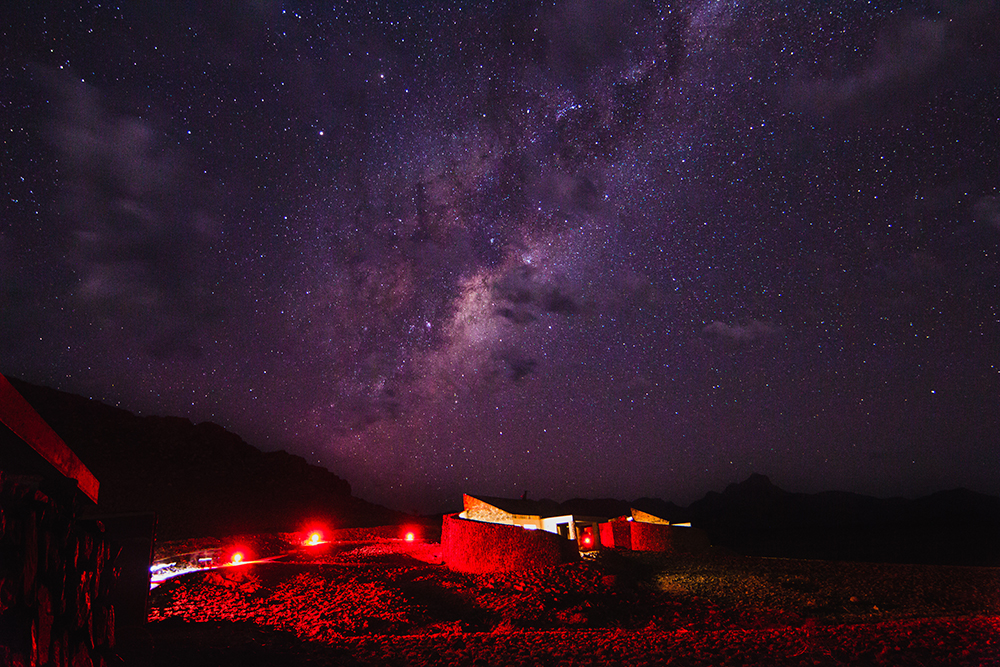It goes without saying that Namibia is among my favourite countries to visit anywhere in the world. With beautiful scenery, diverse wildlife and wonderful hospitality, a holiday can be a magical experience. After visits in 2011, 2013 and 2014 some might think that I would have exhausted all the country has to offer, but one aspect keeps beckoning to me to return. That feature is the exquisite and wonderfully dark night skies. With a population of only 2.1 million spread across the 34th largest country in the world, one does not need to travel too far before there are no artificial light sources to swamp the delicate light of the Milky Way. Combined with a hot, dry desert climate and you have an environment that lends itself to stargazing.

The stunning views from the petrified dunes are a wonderful backdrop to enjoy a sundowner at sunset.
While there are a number of venues in Namibia that offer a telescopic view of the night sky, and some dedicated astronomy camps, one particular venue holds a special place in my heart after two visits as a guest and one working as the resident astronomer, sharing the wonders of the universe with guests of the lodge. Each of my previous visits had been in late September / early October, so arriving to coincide with the early June New Moon offered an exciting and different view of the sky.
The &Beyond Sossusvlei Desert Lodge
Built on the side of ancient mountain, the lodge gazes out across a long plain that stretches out to distant auburn and sienna coloured petrified dunes. Sleeping just two, each of the 10 guest villas flank the main communal building along a gentle curve, offering excellent privacy. Constructed of local materials including stone, bone, and slate the villa boast floor to ceiling windows allowing the view to continue outwards without interruption. A real highlight is a large skylight above the bed which allows the stargazing to continue when you really should be sleeping.
Constructed in a similar style, the main building offers dining, relaxation areas, a veranda and small swimming pool which is fed by an underground spring. A constant stream of local wildlife including oryx, ostrich, zebra and springbok arrive at a waterhole to quench their thirst which is set a couple of hundred metres in front of communal building. The observatory is located at the rear of the main building slightly up the hill.
There are many activities to keep one occupied during the daylight hours including scenic drives which offer the possibility of spotting a family of cheetahs or a giraffe, a visit to the petrified dunes which is an amazing place to enjoy a sundowner while the sky transforms from a deep blue to reds and oranges which match the dunes themselves. Highly recommended is an early morning balloon flight which is rounded out with a champagne breakfast as well as quad-biking and guided walks. The real highlight though is the journey to the world’s highest sand dunes at Sossusvlei. These ever evolving sand dunes reach up 750 ft high and look stunning as the sun rises over the horizon, with stark shadows highlighting the beautiful twisting dunes which are pushed towards the heavens by competing winds that blow from inland Africa and the coast. Birdwatchers are also well catered for with over 100 species in the area including the adorable and rather tame sociable weavers (keep an eye on your granola at breakfast!)
The Observatory
Set up the hill from the main building, the observatory is approached by red-light illuminated steps which open up into a large circular platform which is surrounded by an almost six-foot-high wall to block what limited light is emitted from the lodge. At its centre is a 12” (305mm) f/10 Meade LX200R which is the same as the current “Advance Coma Free (ACF)” design. It is configured as an Alt-Az on a fork mount and is operated with the 145,000 object database Autostar II controller.
The observatory has a number of eyepieces available for use in a variety of focal lengths though lacks any wider field 2” design EPs. Fortunately, the current visiting resident astronomer had brought along a couple of 2” Nagler and Panoptic eyepieces to supplement the observatory EP collection.
The LX200 is a really fun scope to use, with reliable pointing accuracy and a database that could never be exhausted. However, with a focal length of over 3 metres, achieving really wide fields of view, which some of the larger DSOs towards the centre of the Milky Way and those located in southern celestial hemisphere really need to appreciate, is impossible. I was very much aware of this, and previously took a small scope to compliment the LX200 when I worked as the astronomer. This time was no different, bringing along my Takahashi FS-60Q, a 60mm aperture f/10 quadruplet Apo refractor. As well as offering wide fields of view, I was anxious to test it on Mars, which was only just past opposition, still showing an 18” diameter disc and would ride very near the zenith at this latitude, unlike in the UK where it was lost in the murk and turbulent atmosphere near the horizon.
Resident Astronomer
The resident astronomer whose job it is to guide guests of the lodge around the beautiful night sky are typically posted for two months at a time. The astronomer this time was first timer David Bennett from Hawaii. Advised (should that be warned given my tendency to see the sunrise?) by management that I would be visiting again, David actually knew of me having read my 2013 write-up of four day stay as part of his research into the opportunity at the lodge. David is currently studying to become an operator of one of the professional telescopes in Hawaii. Needless to say, we spent a lot of time together over the following week.
A Gold Rated Dark Sky Reserve
The NamibRand Nature Reserve was awarded gold status from the International Dark Sky Association (www.darksky.org) in 2012. There are three tiers available which categorise how good the night sky is at that particular location. The minimum criteria for each level is shown in the table below.
The NamibRand Nature Reserve is an exceptional location to pursue astronomy. The capital city Windhoek is over 300km away and the lodge itself is more than 90km from neighbouring communities, all of which are small. There is no light pollution at all at lodge’s location and the Milky Way is visible all the way to the horizon. In fact, it is so dark that the zodiacal light can be annoyingly bright pre-dawn, almost spoiling the view of any object of interest in that part of the sky.
With a week of stargazing, the total objects viewed numbered in the hundreds (you should see my observing journal!) so this report will focus on particular highlights for each night.
Sunday:
The day of our arrival coincided with new Moon. I made sure I had introduced myself to David before sunset and made my way up to the observatory prior to dinner to catch a few early evening objects. In all my previous journeys to the southern hemisphere, the Carina region of the Milky Way had already set and Centaurus was low in the sky, which meant waiting till the hours before dawn to have a shot at some of the beautiful DSOs that pepper that region of the Milky Way. In June, they were still riding high in the sky and it was an opportunity I intended to take full advantage of. Conditions that first night were virtually perfect with excellent transparency.
Appearing to the naked eye like a dim star viewing through some very light cloud (hence a Bayer designation), the naked eye view belies what is waiting to greet you in the eyepiece when the scope is pointed towards Omega Centauri. Very much the giant of Milky Way globular clusters, spanning 280 light years across, containing several million stars with a total mass of approximately 5 million suns, that huge size really comes across in wide-field eyepiece with a soft, slightly granular appearance that gently increases towards the centre of the cluster. Spanning more than 50 arc minutes photographically (almost twice the diameter of the full moon!), the visual extent is slightly more modest but very much still in excess of half a degree. The view in the 17mm Nagler (176x / 0.46o) fills the entire field such you could easily be convinced you have pointed the scope at the Milky Way with an uncountable number of tiny pinpricks of light nestled on a gentle glow stretching from one side of the field stop to the other. While the view is impressive, the cluster lacks the intensity variation seen towards the centre of some other GCs, which to me makes the view a little less interesting. However, reminding myself that recent research indicates Omega Centauri is most likely the core of a dwarf galaxy long since consumed by the Milky Way certainly combines with the view to create a stunning visual experience.
The enormous classical constellation of Argo Navis, vessel of Jason and his Argonauts, was split by Nicolas Louis de Lacaille due to its unwieldly size, into Carina, Puppis and Vela, harbours many spectacular DSOs, but one sits very much atop the “striking list.” The Carina Nebula (NGC 3372 / Caldwell 92) is the most visually impressive emission nebula in the night sky. Located in a very rich region of the Milky Way between the Southern Cross, and its imposter, the False Cross, it is unmistakable to the naked eye. NGC 3372 is the largest known H II region in Milky Way stretching more than 200 light years across, dwarfing its more famous northern cousin, the Orion Nebula (M42) whose extent is estimated at around 25 light years. Measuring 120 arc minutes in diameter, the nebula vastly exceeds any field achievable with the LX200, however panning around proves to be very rewarding. The twists, folds and mottling of bright nebulosity appeared to be stitch together like a patchwork blanket by ribbons of cold dark dust that bisect the nebula. In addition to the stunning nebula, Eta Carina is peppered with many open clusters, several of which would be on many observers’ target lists in their own right but are beautifully nested in the warm glowing gas of the nebula.
Staying with the Eta Carina nebula, we then took the power up using a 9mm plossl for 333x to look at the famous Homunculus Nebula of expanding lobes of gas located near the centre of the emission nebula. Stunning Hubble photos of this nebula seem to show a detonation frozen in time, when in reality, several solar masses of material are expanding at speeds of around 1,000km per second. We now know this is remains of the largest explosion a star is known to have survived and was witnessed as a nova in 1843. Spanning roughly 0.8 light years, I was amazed that the distinctive hour glass shape was easily discernible with 1 arc minute diameter lobes either side of bright core. Despite its small size and limited detail, it proved to be one the highlights of the week.
The next object on our hit list was one that somehow I had never observed before. That first look in the eyepiece will stay with me forever. Known as the Hamburger Galaxy, Centaurus A (NGC 5128) is arguably the most intriguing galaxy to be found in the heavens. Not only is just about naked eye visible under a dark sky if you know where to look and hence one of the brightest galaxies in the sky, it is also rather dominant in many parts of the electromagnetic spectrum including radio and gamma-rays. The irregular appearance was an enigma for many years though recent studies have revealed its actual nature. Truly a monster, the galaxy contains over one trillion solar masses with a massive black hole at its centre which is consuming a spiral galaxy that collided with the giant elliptical a few hundred million years ago. Very much visible with direct vision, the thick dark lane that bisects the amorphous glow of the elliptical shows a wealth of mottled structure that extends the length of the long axis before fading into subtle threads that meet the blackness of space. The view in the 17mm Type 4 nicely framed the galaxy with a magnification that revealed plenty of structure. I really do not feel it is an exaggeration to state that this galaxy, above all others I have viewed, most closely resembles long exposure photographs and it has now supplanted NGC 247 as my favourite galaxy.
Monday:
Water is a precious commodity in Namibia. With only 25-150mm of rainfall in the southern deserts per annum, each drop is very welcome. Most of this precipitation arrives during the rainy season of January to March. Before our arrival, 2016 had been a particularly dry year, with the Lodge only recording 8mm of rain in the first five months of the year. The weather was about to step up its game. During the course of the day the cloud had built up though as darkness fell, breaks allowed the starlight to shine through. As we drove back to the lodge from quad-biking on the dunes, I was thinking this would be a night of chasing “sucker holes,” an activity UK based astronomers are all too familiar with. However, those thoughts quickly disappeared with several flashes of lightning on the horizon. What arrived a few hours later put paid to any significant astronomy for the night, though we managed about 30 DSOs in quick succession hoping from one gap to another in the two hours around and after dinner. By 10pm it was over, with the lightning getting ever closer. Thunderstorm after thunderstorm rolled through, and for a desert, a significant amount of rain accompanied them. This would be a night to catch up on some much needed sleep which was probably good thing given we had a 5am wake-up call for a scheduled hot-air-balloon ride. By morning, the storms had passed, though the skies remained cloudy and it was still rather windy. Overnight, 9mm of rain fell, more than doubling the year to date total. Unsurprisingly, the balloon flight was postponed.
Tuesday:
The clouds slowly dissipated during the course of the day and by the late afternoon activity the skies had virtually cleared, salvaging what had appeared earlier in the day to be another rare cloudy day in Namibia. With the astronomy gods once again smiling down on me, I took a new observing list to the observatory that evening.
In my opinion, 47 Tucanae (NGC 104 / Caldwell 106) is the finest globular cluster to be found anywhere in the heavens. It is always near the top of my observing list for trips to the southern hemisphere and it is one of the first objects that springs to mind when I am asked how jealous I am of our southern hemisphere astronomer cousins. 47 Tuc sits just off the edge of the Small Magellanic Cloud (SMC) and is visible to the unaided eye with direct vision. This GC has one of the greatest masses in the Milky Way, containing several million stars and its apparent magnitude is second only to Omega Centauri. The view through the scope also benefits from the fact it is one of the closest GCs to the Sun. In the 27mm Panoptic, the cluster fills a substantial portion of the field and brightness is startling. M22 is the brightest Messier Globular, yet 47 Tuc is three times brighter. In his observing notes, John Herschel described the cluster as “excessively compressed” and every time I view 47 Tuc it is the first thing I notice. The increasing density of stars towards the centre of the cluster creates an extreme concentration of light in the central 3-4 arc minute region, almost like the bright flame of a celestial candle.
Spending some time in the Tucana region of the sky, we used David’s 8×42 binoculars to take in the full extent of the SMC. This small dwarf galaxy spans 7,000 light years and crams in plenty of DSOs, many of which are visible in amateur instruments, including 42mm binoculars. While we managed to identify most of the brighter specks which indicate the presence of a DSO with the star charts we had, one stubbornly refused to conform to any plotted object. We slewed the scope to the mysterious patch of light revealing much more structure though we could not decide if it was a cluster or nebula. Slipping in an OIII filter enhanced the view but darkened the core which indicated it could well have been an emission nebula with a cluster at the centre. However, this information provided no additional help discovering the catalogue number of this object. Defeated but not dejected, we moved on to an object far more familiar to northern hemisphere observers, swinging the scope around to Cygnus which was low in the north.
Should any early civilisations been inclined to gaze skyward several thousand years ago, they may well have found themselves drawn towards a fleeting guest star that would have shone with the brilliance of a full moon. Unknown to them, a massive star had ended its life in a spectacular type II supernova. Today we see the remnant of this cataclysmic end in the form of the beautiful Veil Nebula. This is definitely an object that benefits from the inky black skies of Namibia. Centring the scope on the star 52 Cygni, we spent most of our time with the western loop (NGC 6990 / C34). A long, thin spindle that resembles a colourful witches broom in long exposure photographs, the view is remarkable in the eyepiece using the 27mm Panoptic. Fine gossamer threads twist and turn around each other forming what could be mistaken for a wonderful cometary tail. It is well known that the Veil benefits tremendously from an O III filter given most of the ethereal light from the expanding shell of material radiate at this wavelength, but the contrast that night was so good that we did not bother to use it. In retrospect, I do wish I had used my Takahashi 60 to view the full extent of the loop in a single field, which at 3 degrees is something not possible with the LX200.
Our next port of call was another stellar grave, but this one went with more of a puff than a bang. NGC 6818, known as the Little Gem Nebula is a bright planetary nebula (PN) in Sagittarius, not far from Barnard’s Galaxy (NGC 6822). Using the 17mm Nagler, shows a grey-blue colour with a denser central region and a more tenuous outer envelope extending approximately 20 arcseconds across, roughly the same dimensions as the recent opposition of Mars. As I observed this PN, I felt that intensity dropped slightly in the centre of the nebula, creating the appearance of circlet of material between the less dense core and rarefied outer shell. The magnitude 17 central star, which is on its way to becoming a white dwarf was not seen.
With skies as dark as those found in Namibia, the Milky Way stretches uninterrupted from horizon to horizon, and I find that my gaze is regularly drawn upwards to take in the incredible spectacle of the night sky with the naked eye. Words cannot do justice to just how beautiful the view is. One benefit of cruising the skies without optical aid is you will stumble on bright patches dotted over the sky which suggest the presence of a DSO just begging to be explored with a telescope. Tonight was no different and another bright patch in Carina was almost sign posted by the long axis of the False Cross which pointed directly to it. Identification could wait until we took in the view so the scope was slewed manually with the 27mm Panoptic acting as the looking glass for this unknown object. A wonderful open cluster of 80 to 100 stars with a slightly boxy shape in the centre with numerous spindles of stars radiating away from it was seen. One bright red-orange star stood in stark contrast to the blue-white stars of the rest of the cluster. My impression of a boxy appearance is not a unique one. A quick glance at a star chart showed this cluster is NGC 2516 / C96, which is known as the Southern Beehive and the resemblance is uncanny if probably 1/3 to 1/2 the size of its northern name sake. Reading up on the Southern Beehive the following day showed that the solitary orange star was in fact an interloper being about 350 light years distant compared to the 1,300 of the cluster.
A trip to the largest sand dunes in the world at Sossusvlei and the hauntingly beautiful Deadvlei with associated wake-up call at 5:15am meant we called time on the nights stargazing at around 1am. I have to confess I did sneak another glance or two at the stars through the wonderful skylight above the bed as I dropped off to the sleep.
To continue reading, please follow the link to part two of my week of stargazing in the IDA gold rated NamibRand Nature Reserve.













Pingback: Stargazing in the NamibRand Nature Reserve Part 2 | Alpha Lyrae
Incredible report. Just come across your site for first time. Thanks for sharing these experiences. I’m jealous! Unlikely to be going there soon but wish I could….
Andy
Chair, Rosliston a Astronomy Sgroup, UK.
http://www.astronomy.network
Hi Andy,
Glad you enjoyed reading the report. The skies really are beyond words in Namibia. Really needs to be on every astronomers bucket list.
Clear Skies,
Matthew